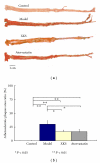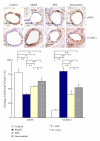Antiatherogenic and Anti-Ischemic Properties of Traditional Chinese Medicine Xinkeshu via Endothelial Protecting Function
- PMID: 22007259
- PMCID: PMC3191825
- DOI: 10.1155/2012/302137
Antiatherogenic and Anti-Ischemic Properties of Traditional Chinese Medicine Xinkeshu via Endothelial Protecting Function
Abstract
Including herbal medicine, complementary and alternative medicine (CAM) is popular worldwide. The traditional Chinese medicine xinkeshu has been widely used to treat coronary heart disease in China. This study was designed to investigate the protective effect and probable mechanism of xinkeshu tablet to atherosclerotic myocardial ischemia rabbit. Rabbits were divided into four groups (n = 12 each) and fed with different diet for 12 weeks: Control (standard diet), Model (high-cholesterol diet), XKS (high-cholesterol diet with 184.8 mg/kg/d xinkeshu), and Atorvastatin (high-cholesterol diet with 5.0 mg/kg/d atorvastatin). Plasma lipoprotein, ECG, endothelium-dependent vessel relaxation, histomorphological study, and expressions of eNOS and VCAM-1 on coronary arteries were assessed. The findings showed that, similar to atorvastatin, xinkeshu presented significant effects on rescuing endothelium-dependent vessel relaxation, inhibiting atherosclerotic progress, preventing myocardial ischemia, and changing eNOS and VCAM-1 expression. However, xinkeshu showed no lipoprotein lowering effect in hypercholesterolemia rabbits. The results of the present study indicated that xinkeshu exerted potent antiatherogenic and anti-ischemic properties on atherosclerotic myocardial ischemia rabbit. An endothelial protecting effect may be involved in the mechanism other than antihyperlipidemic effect.
Figures







Similar articles
-
Xinkeshu Improves Endothelial Function and Augments Reendothelialization Capacity in Coronary Artery Disease with Anxiety/Depression.Oxid Med Cell Longev. 2021 Jul 18;2021:5561272. doi: 10.1155/2021/5561272. eCollection 2021. Oxid Med Cell Longev. 2021. PMID: 34336100 Free PMC article.
-
Xinkeshu tablets promote angiogenesis in zebrafish embryos and human umbilical vein endothelial cells through multiple signaling pathways.J Ethnopharmacol. 2023 Oct 5;314:116636. doi: 10.1016/j.jep.2023.116636. Epub 2023 May 12. J Ethnopharmacol. 2023. PMID: 37182673
-
Chromatographic fingerprinting and quantitative analysis for the quality evaluation of Xinkeshu tablet.J Pharm Anal. 2012 Dec;2(6):422-430. doi: 10.1016/j.jpha.2012.05.006. Epub 2012 Jun 17. J Pharm Anal. 2012. PMID: 29403777 Free PMC article.
-
Effects of Xinkeshu tablets on coronary heart disease patients combined with anxiety and depression symptoms after percutaneous coronary intervention: A meta-analysis.Phytomedicine. 2022 Sep;104:154243. doi: 10.1016/j.phymed.2022.154243. Epub 2022 Jun 10. Phytomedicine. 2022. PMID: 35717809 Review.
-
Xinkeshu for coronary heart disease complicated with anxiety or depression: A meta-analysis of randomized controlled trials.J Ethnopharmacol. 2023 Aug 10;312:116486. doi: 10.1016/j.jep.2023.116486. Epub 2023 Apr 16. J Ethnopharmacol. 2023. PMID: 37072088 Review.
Cited by
-
Standardized Chinese Formula Xin-Ke-Shu inhibits the myocardium Ca(2+) overloading and metabolic alternations in isoproterenol-induced myocardial infarction rats.Sci Rep. 2016 Jul 26;6:30208. doi: 10.1038/srep30208. Sci Rep. 2016. PMID: 27457884 Free PMC article.
-
Therapeutic Effects of Traditional Chinese Medicine on Cardiovascular Diseases: the Central Role of Calcium Signaling.Front Pharmacol. 2021 Jul 9;12:682273. doi: 10.3389/fphar.2021.682273. eCollection 2021. Front Pharmacol. 2021. PMID: 34305595 Free PMC article. Review.
-
Effects and mechanisms of chinese herbal medicine in ameliorating myocardial ischemia-reperfusion injury.Evid Based Complement Alternat Med. 2013;2013:925625. doi: 10.1155/2013/925625. Epub 2013 Oct 31. Evid Based Complement Alternat Med. 2013. PMID: 24288571 Free PMC article. Review.
-
Xinkeshu Improves Endothelial Function and Augments Reendothelialization Capacity in Coronary Artery Disease with Anxiety/Depression.Oxid Med Cell Longev. 2021 Jul 18;2021:5561272. doi: 10.1155/2021/5561272. eCollection 2021. Oxid Med Cell Longev. 2021. PMID: 34336100 Free PMC article.
References
-
- Toshima SI, Hasegawa A, Kurabayashi M, et al. Circulating oxidized low density lipoprotein levels. A biochemical risk marker for coronary heart disease. Arteriosclerosis, Thrombosis, and Vascular Biology. 2000;20(10):2243–2247. - PubMed
-
- Insull W. The pathology of atherosclerosis: plaque development and plaque responses to medical treatment. American Journal of Medicine. 2009;122(supplement 1):S3–S14. - PubMed
-
- Gutterman DD. Silent myocardial ischemia. Circulation Journal. 2009;73(5):785–797. - PubMed
-
- Blum A, Costello R, Samsel L, et al. Variability of C-reactive protein levels among patients with stable coronary artery disease and on statin therapy. Israel Medical Association Journal. 2009;11(10):602–605. - PubMed
-
- Yamashita S, Tsubakio-Yamamoto K, Ohama T, Nakagawa-Toyama Y, Nishida M. Molecular mechanisms of HDL-cholesterol elevation by statins and its effects on HDL functions. Journal of Atherosclerosis and Thrombosis. 2010;17(5):436–451. - PubMed
LinkOut - more resources
Full Text Sources
Miscellaneous

